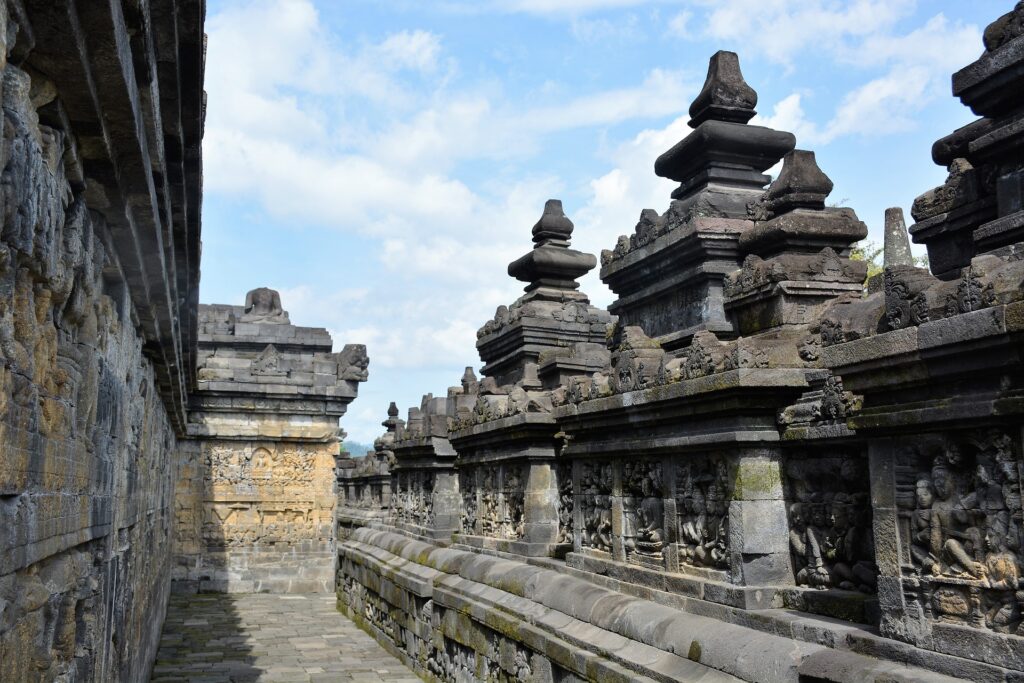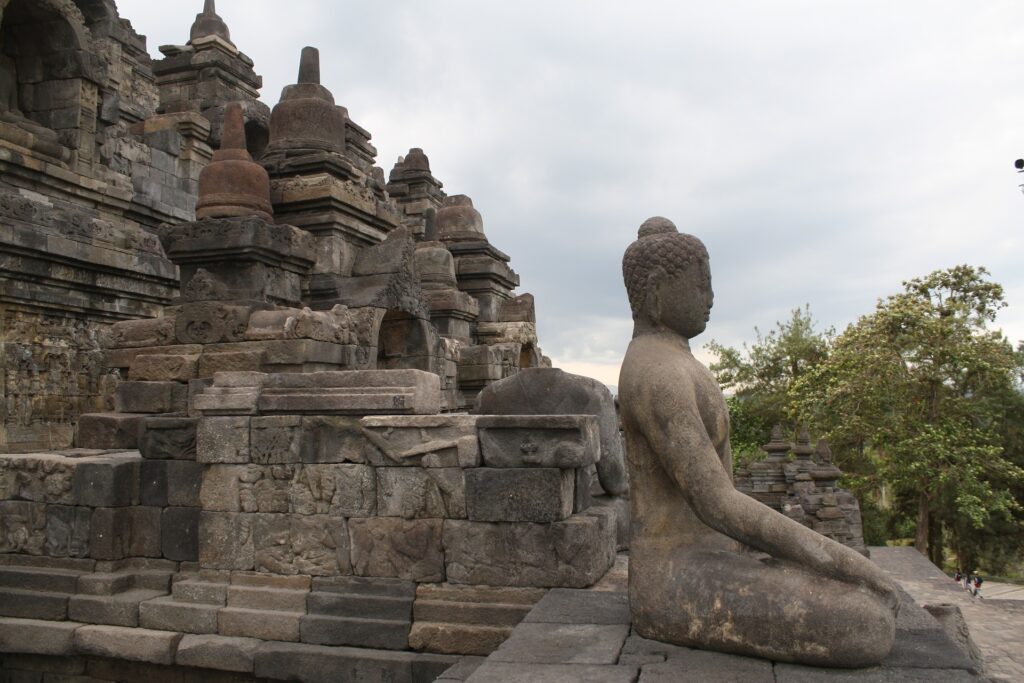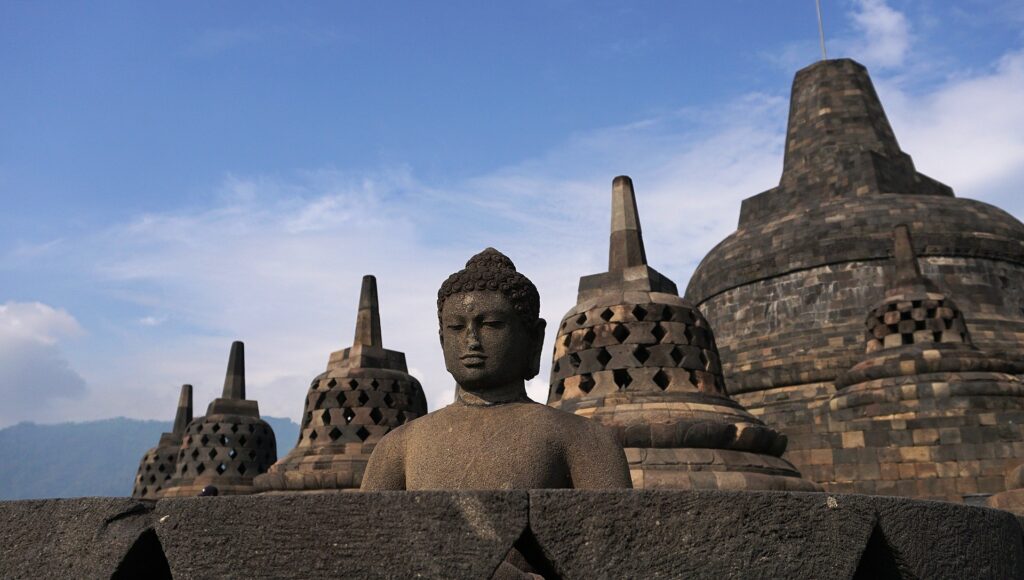Nested in the heart of Java, the ancient cultural epicenter of Indonesia, stands the majestic Borobudur Temple, the world’s largest Buddhist temple. Spanning across centuries, this architectural masterpiece offers a sacred sanctuary for seekers of enlightenment and a glimpse into the rich tapestry of Buddhist art and philosophy.

With deep historical roots dating back to the 8th century, Borobudur was built during the reign of the Syailendra dynasty. Its construction was an ambitious endeavor that mobilized countless artisans, sculptors, and laborers who fervently dedicated themselves to bringing the vision of the temple to fruition.
The temple’s grandeur is an embodiment of Buddhist principles and teachings. Its design meticulously reflects the aforementioned principles, visually representing the path to enlightenment. Rising in tiers, the temple’s structure comprises a monumental stupa crowning the summit, symbolizing total liberation from suffering and the attainment of nirvana.

As one embarks on the journey through Borobudur, each level presents a distinct narrative of Buddhist teachings via intricate carvings. These ornate reliefs depict tales from Buddhist scriptures, such as the Jataka, which highlight moral values and virtues. The narrative unfolds as one progresses from the base of the temple, signifying the cyclical nature of existence, towards higher levels, representing the steps towards spiritual awakening.
More:Read About On Exploring the Magnificent Temples of Angkor
The temple’s three levels mirror the Buddhist cosmology – Kamadhatu, Rupadhatu, and Arupadhatu. The lower level encompasses worldly desires, the middle level signifies self-reflection and meditation, while the upper-most level represents the transcendent state of enlightenment.
As one ascends each tier, the atmosphere transforms, exuding a sense of tranquility and serenity. The rhythmic chants of monks reverberate through the air, further intensifying the spiritual ambiance. The interplay between light and shadow that filters through the temple’s perforated stupas creates an ethereal aura, enchanting visitors and guiding them towards the path of spiritual awakening.

The significance of Borobudur extends beyond its artistic beauty. It serves as a potent reminder of the resilience and perseverance of Buddhism, especially in Java, where the influence of the faith has deep roots. The restoration efforts throughout the years bear testament to the unwavering commitment to preserving this cultural gem.
Visiting Borobudur is not merely sightseeing; it is an introspective journey, an opportunity to delve into the depths of one’s consciousness and explore the teachings of Buddhism. The tranquility that encompasses the temple grounds encourages contemplation, introspection, and meditation – crucial practices for those seeking enlightenment.
visit here:Odishalifestyle
To amplify the spiritual experience, visitors can partake in a Borobudur sunrise tour, where they witness the first rays of sunlight illuminating the temple from the summit. As the world comes to life under the gentle touch of dawn, one can’t help but feel a profound connection to the universe and the teachings of Buddha. This magical experience magnifies the sense of awe and reverence, transcending the mere physicality of the temple.
Borobudur’s grandeur resonates on a global scale. It has been recognized as a UNESCO World Heritage site since 1991, a testament to its cultural significance and historical splendor. Today, it attracts not only devout Buddhists but also tourists from all walks of life seeking a deeper understanding of Buddhism’s tenets.

In conclusion, the ascent to enlightenment at the world’s largest Buddhist temple, Borobudur, is a transformative experience. It offers a unique opportunity to immerse oneself in the depths of Buddhist art, philosophy, and history. As one navigates through its tiers, each step brings us closer to understanding the human condition and the path to awakening. Borobudur reminds us that enlightenment is not confined to the temple but is within reach, waiting to be discovered in the recesses of our own consciousness.
FAQ For On The World’s Largest Buddhist Temple
What is the world’s largest Buddhist temple?
The world’s largest Buddhist temple is Borobudur in Indonesia, a UNESCO World Heritage Site renowned for its stunning architecture and spiritual significance.
What can I expect to experience at Borobudur?
Visitors to Borobudur can ascend its tiers, exploring intricate carvings and serene stupas while soaking in the peaceful and spiritual ambiance.
Are there any guidelines for visiting Borobudur temple?
Yes, visitors are requested to dress modestly and respect the sacredness of the temple by refraining from loud noises and engaging in respectful behavior.
How can I reach Borobudur temple?
Borobudur is located near Yogyakarta in Indonesia and can be reached by various modes of transportation, including taxi, private car, or organized tours.
Is there a good time to visit Borobudur temple?
It’s recommended to visit Borobudur temple early in the morning to witness a breathtaking sunrise and avoid crowds.
Are there any restrictions on photography at Borobudur temple?
Photography is permitted at Borobudur temple, but drone usage is prohibited and visitors are advised to be mindful of others while taking pictures.
What are some nearby attractions I can visit after exploring Borobudur temple?
Nearby attractions include the Prambanan temple complex, Mount Merapi, and the bustling city of Yogyakarta offering a rich cultural experience.
Are there any local customs or traditions I should be aware of while visiting Borobudur temple?
It’s respectful to remove your shoes before entering the temple, refrain from pointing your feet towards sacred objects, and to always greet locals with a smile and a nod.

